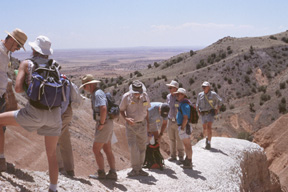geotimesheader
News
Notes
Geologic
History
Grand Canyon
quandary
About 75 experts assembled in Grand Canyon Village,
Ariz., June 7-9 for a meeting of the minds on the origin of the Grand Canyon.
They debated the evolution of the landscape, formation of the canyon, age
of Quaternary deposits and timing of fault movements. Not since 1964, when
the last organized gathering of scientists debated the issue, has the geologic
marvel received such concentrated scrutiny.
Interest in a Grand Canyon meeting intensified
at a Geological Society of America conference two years ago. At an
informal gathering, several geologists decided that a reconsideration of
new data was long overdue. As a result, this year’s meeting focused on
examining the diverse data sets collected in recent years, including extensive
potassium-argon age dating.
The majority of professional researchers at the
meeting agreed that the modern Colorado River probably did not flow to
the Gulf of California until 4.5 million to 6 million years ago. Most also
acknowledged strong evidence that a significant amount of the deep-canyon
cutting in the upper Colorado River could have occurred within the last
million years.
“I was impressed by the diverse lines of evidence
presented to support that the last 1,000 to 1,500 feet of the eastern Grand
Canyon were cut in the last million years,” says geologist Stephen Reynolds
of Arizona State University. Most of the canyon was eroded between 4 million
and 6 million years ago. But over the past three decades, scientists have
increasingly suspected that significant changes in the eastern canyon occurred
over a short time frame. Only now are multiple lines of support emerging,
says conference organizer Richard Young of the State University of New
York at Geneseo. |

Grand Canyon conference field trip to eastern Arizona
(Navajo Reservation) to examine sediments deposited
in Lake Hopi (Bidahochi Formation), considered a
possible temporary basin to store water of an early
(ancestral) upper Colorado River between 5 million and
16 million years ago. Richard Young, SUNY Geneseo. |
According to co-organizer George Billingsley of
the U.S. Geological Survey (USGS), the large amount of Quaternary activity
along Hurricane fault supports the relatively young age of the eastern
canyon. It is now thought the normal fault did not exist before 2.5 million
years ago. As the major north-south trending fault in the western Grand
Canyon significantly lowered the terrain to the west, the Colorado River
could have responded by rapidly downcutting in the east to regain equilibrium.
“I think it’s the Hurricane fault that caused the downcutting,” Reynolds
says,
adding that all known evidence for downcutting
is upstream, east of the fault.
Estimated Quaternary downcutting rates also support
a geologically recent origin. The rates are rapid enough to account for
the latest stage of eastern canyon formation during the last million years,
Young says. Based on the research by Ivo Lucchitta and Tom Hanks of the
USGS and consultant Sid Davis, Quaternary deposits upstream from the Grand
Canyon, near Glen Canyon, produced the youngest age constraint, limiting
parts of the eastern canyon erosion to within the last 700,000 years.
One theory on overall Grand Canyon formation combines
evidence for older and younger ages of origin. In the past, canyon formation
was attributed to cutting or to a large-scale erosional stripping of sedimentary
rocks off the Colorado Plateau, a process called the “Great Denudation.”
Graduate student Andre Potochnik of Arizona State University suggests that
rivers flowing to the northeast more than 30 million years ago established
parts of the course of the Colorado River. Mesozoic rocks may have been
stripped around this time, Reynolds says, but the final notching of the
deeper canyon could have occurred much later.
Bridget Mulvey

